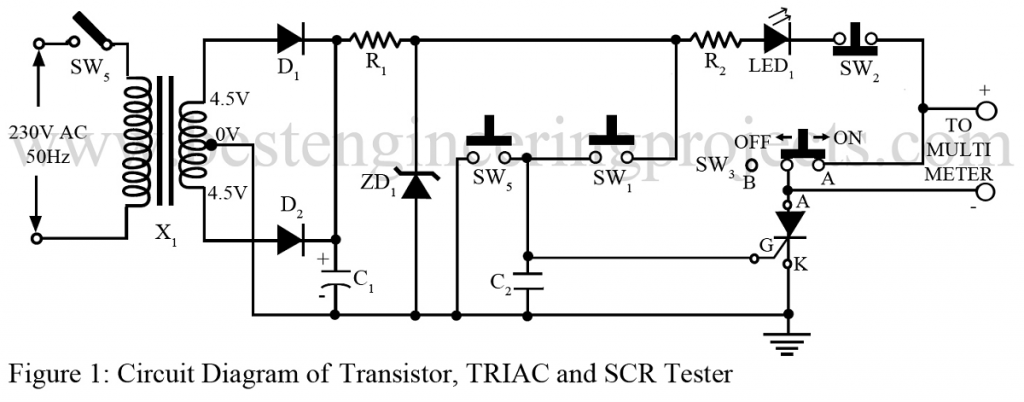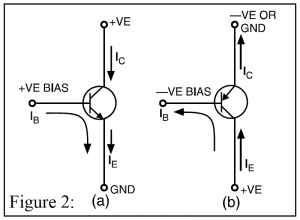In different types of electronic circuits, you might have seen multiple elements in common. Some of these commonly used semiconductor devices, without which electric circuits are almost incomplete are SCRs, transistors, and TRIACs. In broad electronics circuits when small elements fail to function, its consequence affects the performance of the whole circuit. So, before building the overall circuit, one must be wise enough to check the functioning of circuit elements to avoid future complications. The Transistor, TRIAC, and SCR Tester Circuit presented below assists us in a similar way to test SCRs, TRIAC’s, and PNP, NPN transistors.
Circuit Description of Transistor, TRIAC, and SCR Tester Circuit
The transistor tester circuit operates on a DC supply. This supply is derived from special arrangements of a zener diode in conjunction with a step-down transformer and rectifier, as illustrated in figure 1. In spite of using this arrangement, we can also provide the power supply for this circuit using two pencil cells.
SCR Testing | Transistor, TRIAC, and SCR Tester Circuit
First of all, let’s talk about testing an SCR using a transistor tester circuit. Initially, it is inserted in the socket with terminals inserted in proper slots. Then, we slide switch SW3 to the “on” position (towards A) and press switch SW1 briefly. On doing so, the LED glows and glowing continues until switch SW2 is pressed. Here main supply to the step-down transformer is interrupted for a moment with the help of switch SW4. This indicates that SCR under test can be used without being doubtful.
Similarly, if switch SW3 is in the “off” position (towards B), the current flowing through the SCR can be monitored by connecting a multi-meter or a milli-ammeter. If LED doesn’t glow till the end, SCR used is no good or it can’t function properly. LED glowing by itself indicates the faulty i.e. leaky SCR. The only case where SCR is serviceable is when LED glows on pressing switch SW1 for a moment and goes off on pressing switch SW2.
TRIAC Testing | Transistor, TRIAC and SCR Tester Circuit
Similarly, in the case of TRIAC testing using transistor tester circuit, the respective terminals must be connected properly-MT1 terminal to point A (positive), MT2 terminal to point K (negative), and its gate to point G. after setting this arrangement, on pressing switch SW1 for a short period, LED glows. If switch SW2 is pressed briefly, LED goes off. Again, on pressing switch SW5, LED doesn’t glow.
Now we reverse the direction of MT1 and MT2, i.e. terminal MT1 is connected to negative and MT2 to positive. On pressing switch SW2, if LED remains in an off state and conduction is not initiated, the TRIAC is working properly. And, at the same time, the depression of switch SW5 shortly initiates TRIAC conduction and LED glows.
Faulty TRIAC shows similar behavior as SCR. The TRIAC under test can be considered good or useable only when LED glows in both above-mentioned tests.
One should be much careful to check anode MT1s connection with the case before connecting SCR/TRIAC for testing. TRIAC consists of two SCRs connected back to back. The first accepts a positive pulse for conduction while the second accepts a negative pulse for conduction.
Transistor Testing | Transistor, TRIAC, and SCR Tester Circuit
In order to check transistors using transistor tester circuit, a few resistors of about 1 KΩ must be added to the circuit between the junction of switches SW1, SW5, and point G. The arrangement must be so set that the collector of NPN or emitter of PNP transistor must be connected to positive (point A). Similarly, the emitter of NPN and the collector of a PNP transistor are connected to the negative (point K. In both cases, the gate is connected to point G.
For NPN transistors, on pressing switch SW1, LED glows, and on releasing/lifting finger, it goes off. This signifies transistor is useable. Similarly, PNP transistors under test are considered good only when LED glows on pressing switch SW5 and goes off when released. The continuous glow of LED by itself indicates faulty leaky SCR or transistors. Figure 2 shows the conventional current direction and forward biasing condition for PNP and NPN transistors.
Check out other electronic tester circuits posted in bestengineeringprojects.com
- Digital AC/DC Voltage cum Continuity Tester
- RJ45 Cable Tester Circuit
- Zener Diode Tester Circuit
- Servo Motor Tester Circuit Using 555 IC
- 5 State Digital IC and Circuit Tester
- 555 Timer IC Tester
PARTS LIST OF TRANSISTOR, TRIAC, AND SCR TESTER CIRCUIT
| Resistor (all ¼-watt, ± 5% Carbon) |
| R1 = 220 Ω
R2 = 100 Ω |
| Capacitors |
| C1 = 1000 µF, 16V (Electrolytic capacitor)
C2 = 0.01 µF (Ceramic Capacitor) |
| Semiconductors |
| D1, D2 = 1N4001 (Rectifier Diode)
ZD1 = 3.3V, 400mA zener diode |
| Miscellaneous |
| X1 = 230V AC primary to 4.5V-0-4.5V 100mA sec. transformer
SW1, SW5 = PUSH-TO-ON switch SW2 = PUSH-TO-OFF switch SW3 = Slide Switch SW4 = Toggle Switch |

